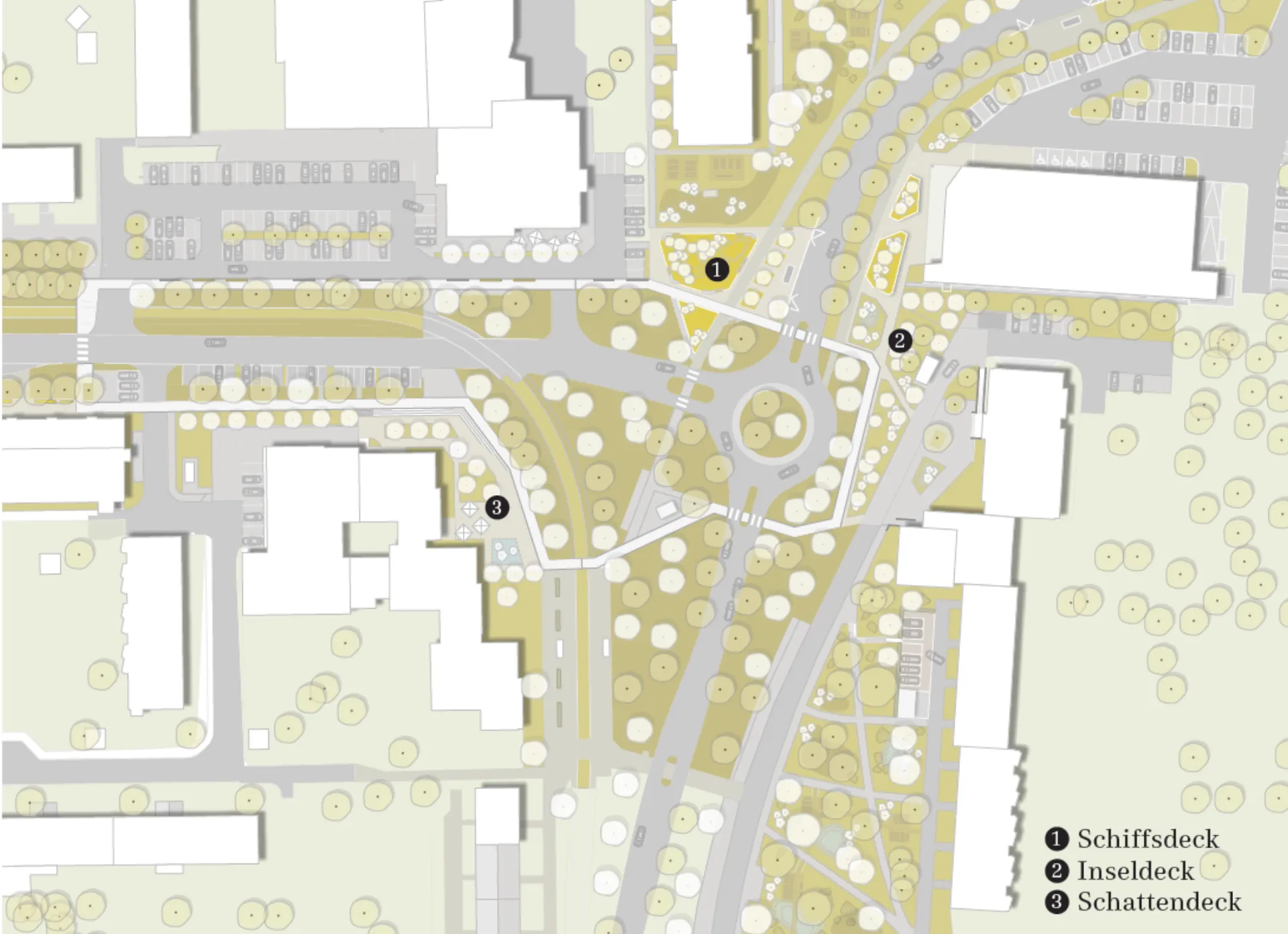According to the framework plan for the Nordhausen-Nord Climate Quarter, the Stadtloop aims to transform the neighborhood center, which is currently dominated by through traffic, into a more urban district center with short distances. At the same time, the Stadtloop aims to provide a transferable and scalable solution for a resource-efficient and socially acceptable conversion of public areas that has a low ecological footprint in terms of resource use. This will be made possible through the development of three real laboratories as climate action spaces and the testing of a climate arboretum for urban climate-resistant tree species, as well as through the recycling of existing resources. In the heavily used traffic area of the neighborhood center, public transport as well as pedestrian and bicycle traffic will have priority in the future.
The Stadtloop creates an accessible path through the entire district center and provides access to important functions such as stops, supermarkets, community centers, nursing homes, and retail stores. The sealed surfaces for the Stadtloop and the adjacent areas will be minimized, and the existing substructures will be tested and reused as much as possible for the new surfaces. For necessary new surface coverings, materials with a high proportion of recycled content will be used, which reflect sunlight more strongly in light colors and thus reduce heat absorption and mitigate the heat island effect.
 The Stadtloop reconnects the central district with low resource usage. It includes three climate action spaces integrated as real-world laboratories for climate impact. Graphic: HEINISCH Landscape Architects.
The Stadtloop reconnects the central district with low resource usage. It includes three climate action spaces integrated as real-world laboratories for climate impact. Graphic: HEINISCH Landscape Architects.
A total of three different climate action spaces are planned for the Stadtloop, focusing on heat, heavy rain, and storm events. The partial spaces will receive a thematic design and thereby obtain their recognition value. Topography, spatial distribution, surface and vegetation selection will respond to the expected climate impacts (e.g. overheating) and reveal transferable adaptation strategies. The climate action spaces ›Ship's Deck‹, ›Island Deck"‹ and ›Shadow Deck‹ are created.
Within the Stadtloop, a climate arboretum with tree species is created that can adapt to the prevailing conditions on-site. A large variety of different tree species that have already proven promising in other cities are planned for planting. Planting the most diverse range of tree species possible should lead to a natural selection process that establishes the tree species that cope best with the site conditions in Nordhausen-Nord with regard to wind position, dryness, soil compaction, and emission load. Green areas in the form of low-maintenance wildflower meadows grow beneath the arboretum, which tolerate the mentioned site conditions and represent an enrichment for biodiversity. The high proportion of green spaces on the square also prevents the development of micro-climatic heat islands and serves as valuable living space.
In addition to the individual design of the climate action spaces, new seating furniture with recurring design features will be used along the Stadtloop. With uniform color and arrangement, an identity-creating and publicly usable urban space in Nordhausen-Nord will grow.
To accompany and make the upcoming conversion manageable, HEINISCH Landscape Architects from Weimar will provide early involvement and networking of property owners, social organizations, and local actors in the conversion process to coordinate the numerous individual needs. To make the conversion tangible for everyone, information stations will be set up along the Stadtloop starting in 2023 and later in the climate action spaces themselves.
Location
Projektträgerin
Stadt Nordhausen
IBA Projektleiterin
Kerstin Faber
Projektprozess
Klimaregion Nordhausen im IBA Finale 2023
01.03.23
...
IBA Fachbeirat empfiehlt Kandidatenstatus für die Klimaregion Nordhausen
30.09.14
...
Im Drupal zeigen